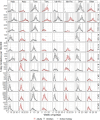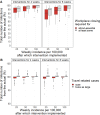The effect of policy measures, school holidays and travel on the incidence of SARS-CoV-2 infection in children and adults in Estonia from 2021 to 2022
- PMID: 40608757
- PMCID: PMC12225823
- DOI: 10.1371/journal.pone.0327719
The effect of policy measures, school holidays and travel on the incidence of SARS-CoV-2 infection in children and adults in Estonia from 2021 to 2022
Abstract
Purpose: The policy measures implemented during the COVID-19 pandemic, travel and school holidays could have influenced the spread of SARS-CoV-2 infection in children and adults differently. We aimed to determine the effect of policy measures, school holidays and travel on the incidence of SARS-CoV-2 infection in children and adults.
Methods: The overall SARS-CoV-2 infection incidence between 1 February 2021 and 1 May 2022 was decomposed into the most common lineage-specific incidence per 100,000 by imputing lineage based on the sequencing results of random samples. A phenomenological logistic growth model was fitted to the incidence data in adults (aged ≥15 years) and children (aged <15 years) in four regions in Estonia. Factors influencing the spread of the virus, such as policy measures, school holidays, the number of travel-related cases, and cumulative vaccination or infection rates, were tested as covariates in the model.
Results: The eleven most common lineages (one Alpha, six Delta, two Omicron BA.1, and two Omicron BA.2) caused 84.7% and 85.8% of all SARS-CoV-2 infections in children and adults, respectively, during the study period. According to the final model, the Delta variant had slower growth and a lower maximum cumulative incidence. The number of workplace closures in the previous week and school holidays in the same week decreased, but the number of travel-related cases in the same week increased the incidence growth. No difference between children and adults was observed. The testing rate was lower during school holidays than during school terms (median (IQR) 1964 (1437-2970) vs. 3136 (2476-4417) vs. per 100,000; p < 0.001). In 40.3% of the weeks, travel-related cases were detected, accounting for (IQR) 2.1% (0.9-4.3%) of the incidence of nontravel-related infections.
Conclusion: Our study suggests that the spread of SARS-CoV-2 infection was similar in children and adults. Workplace closures reduced transmission, whereas during school holidays lower testing contributed to a lower reported incidence, and travel-related cases were possibly underreported.
Copyright: © 2025 Soeorg et al. This is an open access article distributed under the terms of the Creative Commons Attribution License, which permits unrestricted use, distribution, and reproduction in any medium, provided the original author and source are credited.
Conflict of interest statement
The authors have declared that no competing interests exist.
Figures



Similar articles
-
Measures implemented in the school setting to contain the COVID-19 pandemic.Cochrane Database Syst Rev. 2022 Jan 17;1(1):CD015029. doi: 10.1002/14651858.CD015029. Cochrane Database Syst Rev. 2022. Update in: Cochrane Database Syst Rev. 2024 May 2;5:CD015029. doi: 10.1002/14651858.CD015029.pub2. PMID: 35037252 Free PMC article. Updated.
-
Antibody tests for identification of current and past infection with SARS-CoV-2.Cochrane Database Syst Rev. 2022 Nov 17;11(11):CD013652. doi: 10.1002/14651858.CD013652.pub2. Cochrane Database Syst Rev. 2022. PMID: 36394900 Free PMC article.
-
Workplace interventions to reduce the risk of SARS-CoV-2 infection outside of healthcare settings.Cochrane Database Syst Rev. 2022 May 6;5(5):CD015112. doi: 10.1002/14651858.CD015112.pub2. Cochrane Database Syst Rev. 2022. Update in: Cochrane Database Syst Rev. 2024 Apr 10;4:CD015112. doi: 10.1002/14651858.CD015112.pub3. PMID: 35514111 Free PMC article. Updated.
-
Rapid, point-of-care antigen tests for diagnosis of SARS-CoV-2 infection.Cochrane Database Syst Rev. 2022 Jul 22;7(7):CD013705. doi: 10.1002/14651858.CD013705.pub3. Cochrane Database Syst Rev. 2022. PMID: 35866452 Free PMC article.
-
Signs and symptoms to determine if a patient presenting in primary care or hospital outpatient settings has COVID-19.Cochrane Database Syst Rev. 2022 May 20;5(5):CD013665. doi: 10.1002/14651858.CD013665.pub3. Cochrane Database Syst Rev. 2022. PMID: 35593186 Free PMC article.
References
-
- Koslow W, Kühn MJ, Binder S, Klitz M, Abele D, Basermann A, et al. Appropriate relaxation of non-pharmaceutical interventions minimizes the risk of a resurgence in SARS-CoV-2 infections in spite of the Delta variant. PLoS Comput Biol. 2022;18(5):e1010054. doi: 10.1371/journal.pcbi.1010054 - DOI - PMC - PubMed
-
- Aiewsakun P, Jamsai B, Phumiphanjarphak W, Sawaengdee W, Palittapongarnpim P, Mahasirimongkol S. Spatiotemporal evolution of SARS-CoV-2 in the Bangkok metropolitan region, Thailand, 2020-2022: implications for future outbreak preparedness. Microb Genom. 2023;9(12):001170. doi: 10.1099/mgen.0.001170 - DOI - PMC - PubMed
MeSH terms
LinkOut - more resources
Full Text Sources
Medical
Miscellaneous

